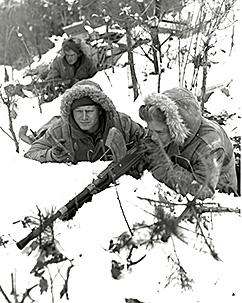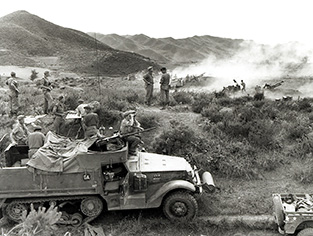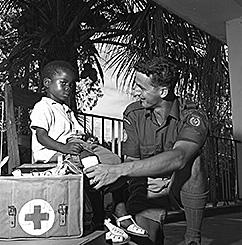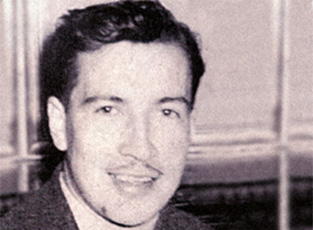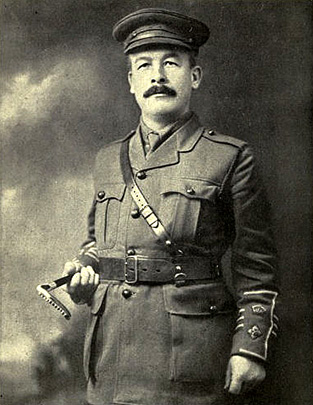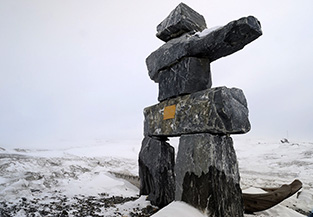Canada Remembers Times - 2015 Edition - Page 3
The Korean War – 65 Years Later
Canadian soldiers in snowy Korea in 1951.
(Photo: Library and Archives Canada PA-128817)
The Korean War erupted in the Far East, 65 years ago, when North Korean troops poured over the border into South Korea on June 25, 1950, touching off over three years of bitter fighting. More than 26,000 Canadians would courageously serve with United Nations forces on land, at sea and in the air during this conflict. Alberta’s Ray Nickerson enlisted in the Canadian Army at age 16 and served in Korea. He remembers his first encounter with the enemy:
“[...] We took an attack at night [...] one wave and another wave behind and another wave behind, like, it seemed like they had endless, endless, endless men. [...] And it was pretty damn scary when the flares were going up and you could see all these, it looked like a bunch of ants crawling around, coming up the hills [...] it was scary, but you knew you had a job to do and you had to do it, you know.”
When an armistice was finally signed on July 27, 1953, the border was back close to where it had been before the war. Canada had helped restore peace and freedom to the people of South Korea—a peace paid for in part by the 516 Canadian servicemen who died during the war. No formal peace treaty was ever signed, however, and tensions along the border between North and South Korea remain high today.
A Train Tragedy
The 2nd Regiment, Royal Canadian Horse Artillery in action in Korea.
(Photo: Library and Archives Canada PA-128280)
The dangers of serving in times of war are not only the obvious ones of guns and bombs. Often the risks can begin with enlistment and training. The tragedy that struck the 2nd Regiment, Royal Canadian Horse Artillery, 65 years ago during the Korean War, shows how true this is.
On November 21, 1950, the soldiers were on their way from Camp Shilo in Manitoba, to Fort Lewis in Washington State for additional preparation and then shipping out for Korea. Near Canoe River, British Columbia, their troop train accidentally collided head-on with another train that was on the same track. The engine and front passenger cars derailed and slid down an embankment.
Some of the unhurt soldiers frantically dug out the injured and dead from the wreckage, using their rifles to pry the twisted debris to get their comrades free. Sadly, 12 soldiers died in the crash and another five would die of their injuries soon after. The names of these men can be found among the 516 Canadians inscribed in the Korean War Book of Remembrance.
Did You Know?
The Books of Remembrance, which list the more than 118,000 Canadians and Newfoundlanders who have given their lives in service for our country since Confederation, are located in the Memorial Chamber of the Peace Tower on Parliament Hill in Ottawa. In November 2014, striking new carved altars were unveiled on which the Books are now displayed.
Canadians in the Congo
Canadian soldier bandages a child’s leg in the Congo in 1963.
(Photo: Department of National Defence UNC63-39-5)
The year 2015 marks the 55th anniversary of Canada’s first military efforts in the Congo to try to help bring peace and stability to the troubled African country. Hundreds of Canadians would serve there as part of a large-scale United Nations (UN) peacekeeping mission that ran from 1960 to 1964.
It would be very challenging duty for those tasked with peacekeeping in a place with so little peace to keep. Weapons and violence were widespread in a country that had been virtually reduced to chaos after the former Belgian colony had gained its independence.
Despite some successes, in the end the UN troops were unable to stop the greater forces of upheaval rocking the Congo and they departed in 1964. Two Canadian soldiers died during the mission.
Unfortunately, the situation in the Congo has remained troubled and a small Canadian Armed Forces contingent has again been serving in the country in recent years.
An Ojibwa Airman Flies High
Flying Officer Willard Bolduc, DFC.
(Photo courtesy of the Bolduc family)
More than 3,000 Aboriginal-Canadians volunteered from every region of the country to serve in the Second World War. One of those courageous individuals was Willard Bolduc, an Ojibwa man from Chapleau, Ontario.
Bolduc’s father, Telesfore, had lost his life while serving with the Canadian Railway Troops during the First World War. Willard followed this family tradition of service and joined the Royal Canadian Air Force during the Second World War. He trained in Mont-Joli, Quebec, at the No. 9 Bombing and Gunnery School and graduated in September 1942.
Pilot Officer Bolduc served with the Royal Air Force’s No. 15 Squadron, flying dangerous bombing missions over occupied Europe. As a gunner, he helped repel enemy fighter attacks on his aircraft during missions to targets like Cologne and Nuremberg. Bolduc was awarded the Distinguished Flying Cross in 1944 for his courage under fire.
Sam Sharpe - A Man of Duty
Lieutenant-Colonel Samuel Sharpe, DSO during the war.
(Photo: Public domain)
Samuel Simpson Sharpe was born in 1873 in Zephyr, Ontario. He became a lawyer in Uxbridge and was first elected to represent the area in the House of Commons in 1908. He also served in the militia and when the First World War broke out he helped recruit the 116th (Ontario County) Battalion in which he would also serve.
Lieutenant-Colonel Sharpe served bravely in a number of actions like the Battle of Vimy Ridge and Passchendaele and was awarded the Distinguished Service Order.
In 1918, remarkably, he would also be re-elected to Parliament in absentia while overseas, the only federal politician to do so.
The strain of the battlefield took a great toll, however, and Sharpe’s mental health began to suffer. He was sent back to Canada and hospitalized for nervous shock. Tragically, he took his own life in a Montréal hospital on May 25, 1918.
Invisible psychological wounds like those suffered by Sharpe were not as understood back then. Fortunately many strides have been made and more help is available today for Canadian Armed Forces members who have suffered operational stress injuries in our country’s more recent military efforts.
A Dangerous Northern Rescue
Inuksuk near CFS Alert in Nunavut.
(Photo: Department of National Defence IS2010-3015-02)
When ships run into problems at sea or aircraft go down in remote areas, Canadian Armed Forces members are often first on the scene to aid those in distress. These missions can be very dangerous and challenging, like when a Hercules military transport plane went down near CFS Alert in the High Arctic in October 1991. In a raging blizzard, search and rescue technicians were sent to parachute down to the crash site at night. Sadly, five on the downed plane had died but the rescuers helped save the lives of 13 survivors.
- Date modified:
